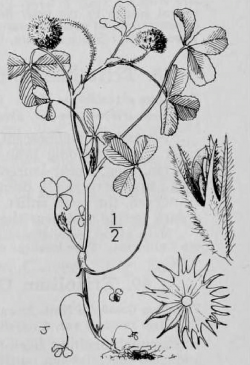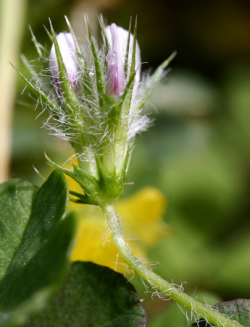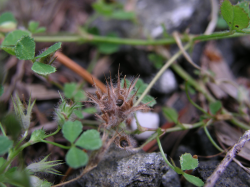
endangered

Illustration from Abrams (1944).

Photo taken in Mendocino County © 2011 Kerry Heise.

Photo © 2011 Kerry Heise.



This fact sheet was prepared by Grey F. Hayes and Dean W. Taylor under award NA04N0S4200074 from the National Oceanic and Atmospheric Administration (NOAA), U.S. Department of Commerce (DOC). The statements, findings, conclusions, and recommendations are those of the authors and do not necessarily reflect the views of the NOAA or the DOC.
© Copyright 2006, Elkhorn Slough Coastal Training Program
Last updated: Jan 30, 2015 13:08
Common Names - Monterey clover
Family - Fabaceae (Legume Family)
State Status - state endangered
(November 1979)
Federal Status - federal endangered
(August 1998)
Habitat
Meadow openings in Monterey Pine forest, or in forested sites following hot crown fires; < 100 m.
Key Characteristics
Spreading annual herb, initially sparsely hairy, in age more-or-less glabrous below inflorescence; stipules toothed or lobed; leaflets 3, oblanceolate to obovate, 5–10 mm long and ca. 5 mm wide at most; inflorescence capitate, included or exserted, with 1–10 flowers, involucre reduced, cut past middle, glabrous or hairy; calyx 6–7 mm long, hairy, lobes generally > tube, bristle-tipped, occasionally more-or-less forked; corolla 6 mm long, pink to lavender. May be a species derived from T. variegatum and a related, non-involucrate species of clover (Vincent and Isely 2013).
Flowering Period
April to June
Reference Population
None in our area.
Global Distribution
Endemic to California in Monterey and Mendocino counties.
Conservation
This disturbance-dependent annual was, until recently, only known to occur in in the central portion of the Monterey Peninsula within a 206-acre area of native Monterey pine forest.
In 2011, approximately 5000 plants were discovered in the Big River Forest in Mendocino County by K. Heise and G. Hulse-Stephens in mixed-evergreen forest along a logging road that had been graded five years previously. The habitat differs markedly “in terms of geology, soils, and forest composition” from that in Monterey (Heise et al. 2012). However, DNA analysis has revealed that plants from the two areas are identical (Ellison et al. 2006). In 2014, several more, considerably smaller, occurrences in Mendocino County were located in similar habitat in the Garcia River Forest. Both areas are monitored annually (K. Heise, personal communication).
The historical abundance and distribution of this species is subject to uncertainty owing to lack of recent fire, and this species is therefore threatened due to suppression of natural fire/disturbance regimen. It has not been observed at the two other mainland Monterey Pine forest sites (Año Nuevo and Cambria) but should be searched for there.
References
Abrams, L. R. 1944. Illustrated flora of the Pacific States, Vol. II. Stanford University Press, Palo Alto, CA.
California Natural Diversity Database (CNDDB). 2015. California Department of Fish and Wildlife. http://www.dfg.ca.gov/biogeodata/cnddb/mapsanddata.asp [accessed 23 January 2015].
CNPS, Rare Plant Program. 2013. Trifolium trichocalyx, in Inventory of Rare and Endangered Plants (online edition, v8-02). California Native Plant Society, Sacramento, CA. http://www.rareplants.cnps.org/detail/1533.html [accessed 23 January 2015].
Doak, D., J. Borgeson, S. Danner, A. Graff, M. Kauffman, P. Shahani, and D. Thomson. 2000 (unpublished). Final report for rare plant management projects: ecological factors affecting the recovery of Gowen cypress (Cupressus goveniana ssp. goveniana, Cupressaceae) and Monterey clover (Trifolium trichocalyx, Fabaceae). Prepared for California Department of Fish and Game, Department of Biology, UC Santa Cruz. http://www.co.monterey.ca.us/planning/major/Pebble%20Beach%20Company/Pebble_Beach_DEIR_Nov_2011/Pebble_Beach_DEIR_Admin_Records_Nov_2011/Jones_Stokes/JS_1996_FinalRecoveryStratSixPlantSpecies.pdf [accessed 23 January 2015]. [in file]
Ellison, N. W., A. Liston, J. J. Steiner, W. M. Williams, and N. L. Taylor. 2006. Molecular phylogenetics of the clover genus (Trifolium–Leguminosae). Molecular Phylogenetics and Evolution 39:688–705.
Heise K., G. H. Stephens, and N. W. Ellison. 2012. New and Noteworthy Collection. Madroño 59(3):167-167.
Jones and Stokes Associates, Inc. 1996. Final recovery strategies for six coastal pant species on the Monterey Peninsula. Prepared for California Department of Fish and Game. http://www.co.monterey.ca.us/planning/major/Pebble%20Beach%20Company/Pebble_Beach_DEIR_Nov_2011/Pebble_Beach_DEIR_Admin_Records_Nov_2011/Jones_Stokes/JS_1996_FinalRecoveryStratSixPlantSpecies.pdf [accessed 5 January 2015].
U.S. Fish & Wildlife Service (USFWS). 2004. Recovery plan for five plants from Monterey County, California. Region 1, Portland, Oregon. http://ecos.fws.gov/docs/recovery_plan/050617a.pdf [accessed 23 January 2015].
U.S. Fish & Wildlife Service (USFWS). 2009. Trifolium trichocalyx, (Monterey Clover), 5-year review: Summary and evaluation. U.S. Fish and Wildlife Service, Ventura Fish and Wildlife Office. Ventura, CA. http://www.fws.gov/ecos/ajax/docs/five_year_review/doc3217.04.09_final.pdf [accessed 23 January 2015].
Vincent, M. A. and D. Isely. 2013. Trifolium trichocalyx, in Jepson Flora Project (eds.) Jepson eFlora, http://ucjeps.berkeley.edu/cgi-bin/get_IJM.pl?tid=47178 [accessed 23 January 2015].
